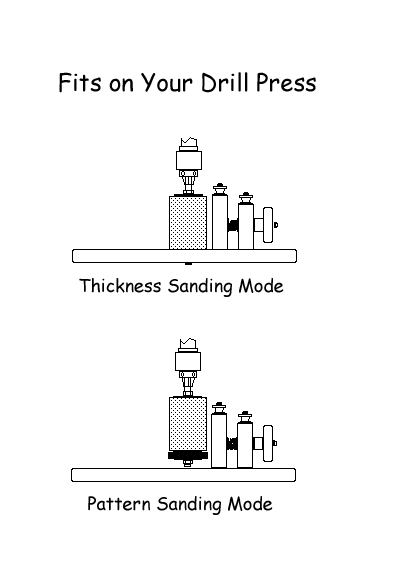
Ken Picou Design
5508 Montview
Austin, TX 78756
(512) 454-3425
Back to Luthiers Friend™ | Back to Robo-Sander™
Working With
The Luthier's Friend™
Precision Sanding Station
Patent 7,004,828

Ken Picou Design
5508 Montview
Austin, TX 78756
(512) 454-3425
Setting Up the Luthier’s Friend™
1. Mount the Robo-Sander™ in the drill press chuck and place the sanding table on the drill press table
2. Adjust the drill press table to a comfortable height so that the Robo-Sander can be raised above the sanding table.
3. Lower the Robo-Sander™ into the large hole on the table so that the guide bearing is beneth the surface of the table. This will position the table accurately.
4. Lock the drill press in the down position.
a. If your press does not have a quill lock, you can fashion one using a stop block and rubber band or a hose clamp.
5. Mount the sanding table to the drill press table making sure that the guide bearing is not binding and the fence is to the right.
I recommend using C- clamps initially. If you wish a cleaner installation you can use lag bolts and washers.
6. Check the alignment between the sanding drum and the fence. The should be perfectly parallel.
This is done as follows:
a. Bring the fence very near to the drum so that you see a narrow slit of light.
b. Lock the fence down
c. Check visually, they should be parallel
d. thickness sand a test piece and measure top and bottom with calipers
7. If necessary adjust tilt of drill press table until drum and fence are parallel. (This is worthwhile for your drilling operations as well)
8. Do a test run with scrap stock before using valuable wood.
Thickness Sanding
Lower the sanding drum into the work table hole so that the lower edge of the abrasive sleeve is about a 1/16” below the edge of the table. Lock the drill press in this position..
Position the fence assembly so that the distance between the sanding drum and the fence is within an 1/8” or so of your final desired thickness.
Lock both the main fence and the lock block by tightening the top hand nuts.
Make an initial rough sanding pass . Feed the wood slowly and steadily through the system . Use a push stick or pull from behind to advance the stock all the way through.. Keep your fingers away from the drum and stand to the side of the piece being sanded...
Loosen the main fence but leave the lock block locked ...The main fence can now be advanced by turning the micro-adjust knob on the lock block counter clockwise ...Lock the main fence and you are ready to make another pass.
Repeat this method untill the final thickness is reached ...You can use your calipers to determine just how much a quarter turn or half turn removes . You can also mark the table for various standard thicknesses that you use .
I have included a dust collection and it works well.. It is designed to accept a 2” Shop-Vac hose but can be bushed down to 1-1/2 with a standard pvc slip bushing .
Pattern Sanding
Wood can be shaped accurately using the template guide system. Attach your template to the underside of the material ..Place the template with attached stock on the work table so that the template material rests flat on the surface . Raise and lock the sanding drum so that the guide wheel is at the proper height to make contact with the template and the abrasive sleeve is in full contact with the material to be shaped.
In many cases the fence assembly can be set to full open position and will not interfere with the shaping of the material . If it appears that there will be a problem, remove the fence assembly . Turn on the drill press and shape your stock with a smooth and steady feed. The guide wheel will stop the sanding process when the wood has been sanded to the shape of the template. For small parts it is best to make a template with a large base to assure that the part is held at a perfect 90- degree angle ..
I would like to hear from you if you have any problems and will help you design templates for parts you want to make.
Freehand Sanding
Lower the drum assembly into the hole and lock in position . The guide wheel becomes a lower support bearing allowing you to use a lot of pressure without deflecting the sanding drum or harming the quill.
Changing Sanding Sleeves
The Sanding sleeves are a compression fit ..Loosen the bottom nut , remove the old sleeve, slide on the new sleeve, and retighten nut.
If the guide wheel binds after changing sleeves , just flip the washers...they can bend if overtightened.
I want to hear from you
Let me know how you like the Luthier’s Friend and what you are using it for ...If you are having any problem , let me know and we’ll get it fixed.
Help me get this going
I made the Luthier’s Friend for craftsmen and I am depending on grass roots marketing to get things jump started. So tell your friends, write to trade journals, and send me testimonials . Let me know how you are using it . Send Photos of your work. You can keep up with current developments by visiting my website...www.luthiersfriend.com
Thanks for your interest in my work